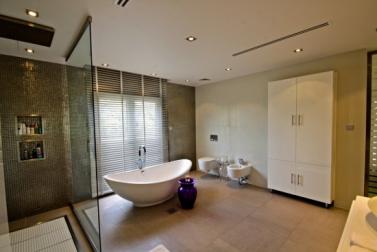Bathing Spaces Become Beautiful

No longer just a functional space, bathrooms are increasingly adopting the attributes of a spa
Words by Anne Martin in Design & Architecture · Mar 5th, 2014
Since the days when Cleopatra bathed in asses' milk, the bathroom has been a special sanctuary. So it's perhaps odd that the bath- room-as-spa concept should be considered a recent phenomenon.
However, with a generation of global nomads benefiting from hotel designers' competing to create the most lavish and beautifully styled bathrooms, it has become the norm recreate those surroundings at home.
It's now a given that every apartment or villa that aspires to the tag 'luxury' should have not only a media room, superb kitchen and gym but bathrooms that are much more than a place to wash: they should be havens for refreshing body, mind and soul. This has given designers and architects huge scope. Some are going ultra-modern and sleek, while others draw inspiration from ancient bathing rituals and classical design.

The bath tub itself has undergone a transformation: no longer is it for washing (that's done in the shower) but for relaxing. As a result, it may feature many elements not previously allowed anywhere near water. To the now commonplace massage jets, add mood lighting, TV sets integrated into mirrors, and even drink chillers. And how much better if the tub has a view. Preferably a sea view, to enhance the feeling of serenity. This, of course, requires total privacy and properties that offer it are rare indeed.
As showers take over the functional role they, too, are becoming more elaborate, with features such as hydrotherapy and even aroma-therapy - the idea being to provide an intense experience in a very short time.

Good lighting is an essential component of every space and, in the bathroom, it plays a vital role in setting a relaxing mood (of course it must be supplemented by excellent task lighting). Going far beyond dimmers and indirect lighting, designers are incorporating coloured light - which is proven to have a great impact on mood and wellbeing.
While simplicity of design remains important (think Zen), hard-edged minimalism and shiny monochrome surfaces are giving way to warmer, natural materials, matte finishes, and richly textured surfaces. Clearly, this once humble room is becoming one of the most valued spaces in the home.